Dental Hygiene in Children: A Health Campaign for Parents and Teachers
VerifiedAdded on 2022/11/28
|9
|2189
|233
Report
AI Summary
This report details a health campaign focused on promoting dental hygiene in children, emphasizing the importance of early intervention to prevent tooth decay and ensure long-term oral health. It identifies key risk factors such as poor oral hygiene, high sugar diets, and limited access to dental care, and targets parents, caregivers, and teachers as the primary audience. The campaign aims to educate the audience on correct brushing techniques, the impact of diet on dental health, and the benefits of regular dental check-ups. It utilizes the Transtheoretical Model and Heider's Balance Theory to influence behavior change, incorporating visuals and demonstrations to enhance understanding and retention. The report also explores the use of social media to disseminate the campaign's message, while acknowledging the challenges in reaching low-income families. References to relevant research support the campaign's strategies and underscore the significance of dental hygiene in children's overall health and well-being.
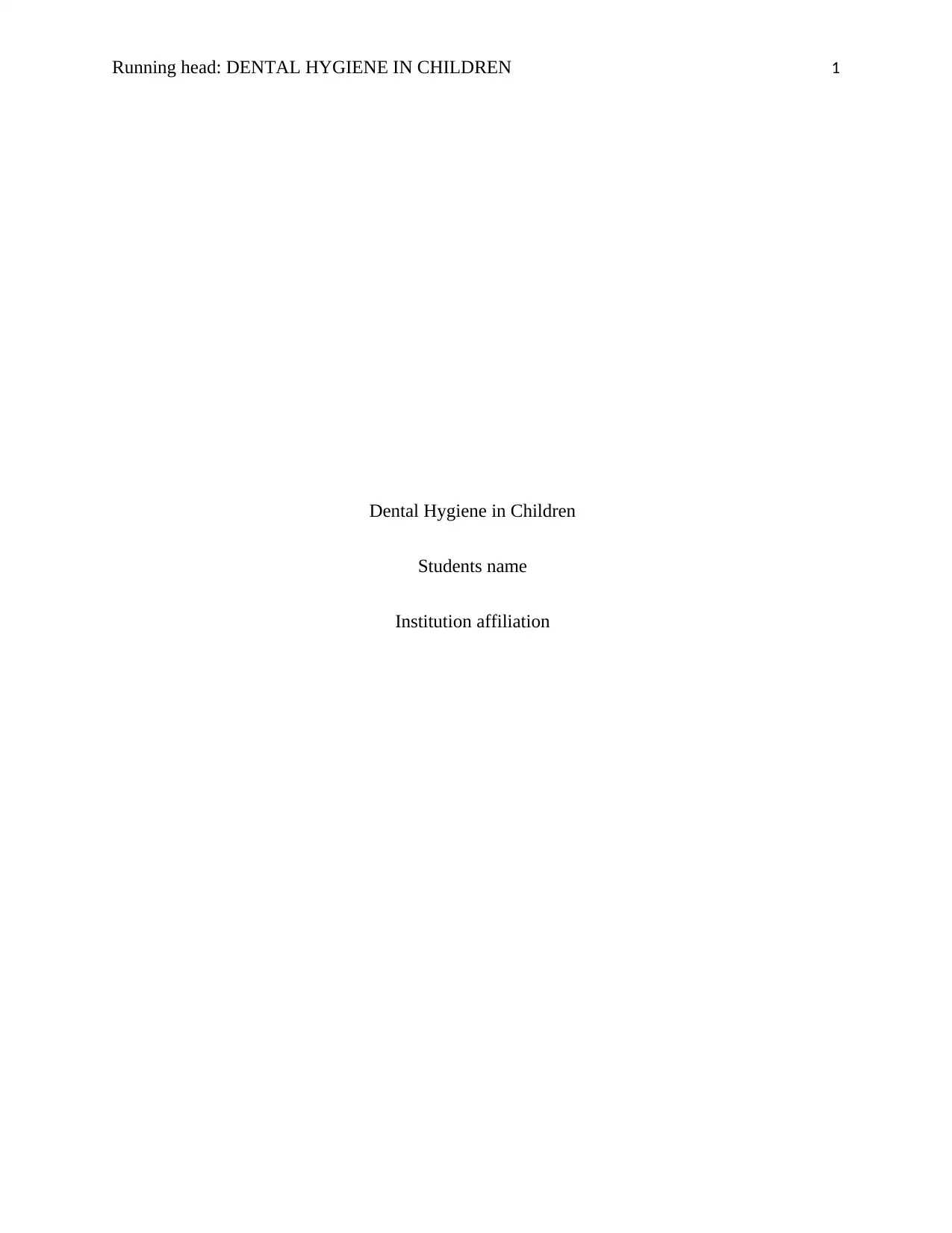
Running head: DENTAL HYGIENE IN CHILDREN 1
Dental Hygiene in Children
Students name
Institution affiliation
Dental Hygiene in Children
Students name
Institution affiliation
Paraphrase This Document
Need a fresh take? Get an instant paraphrase of this document with our AI Paraphraser
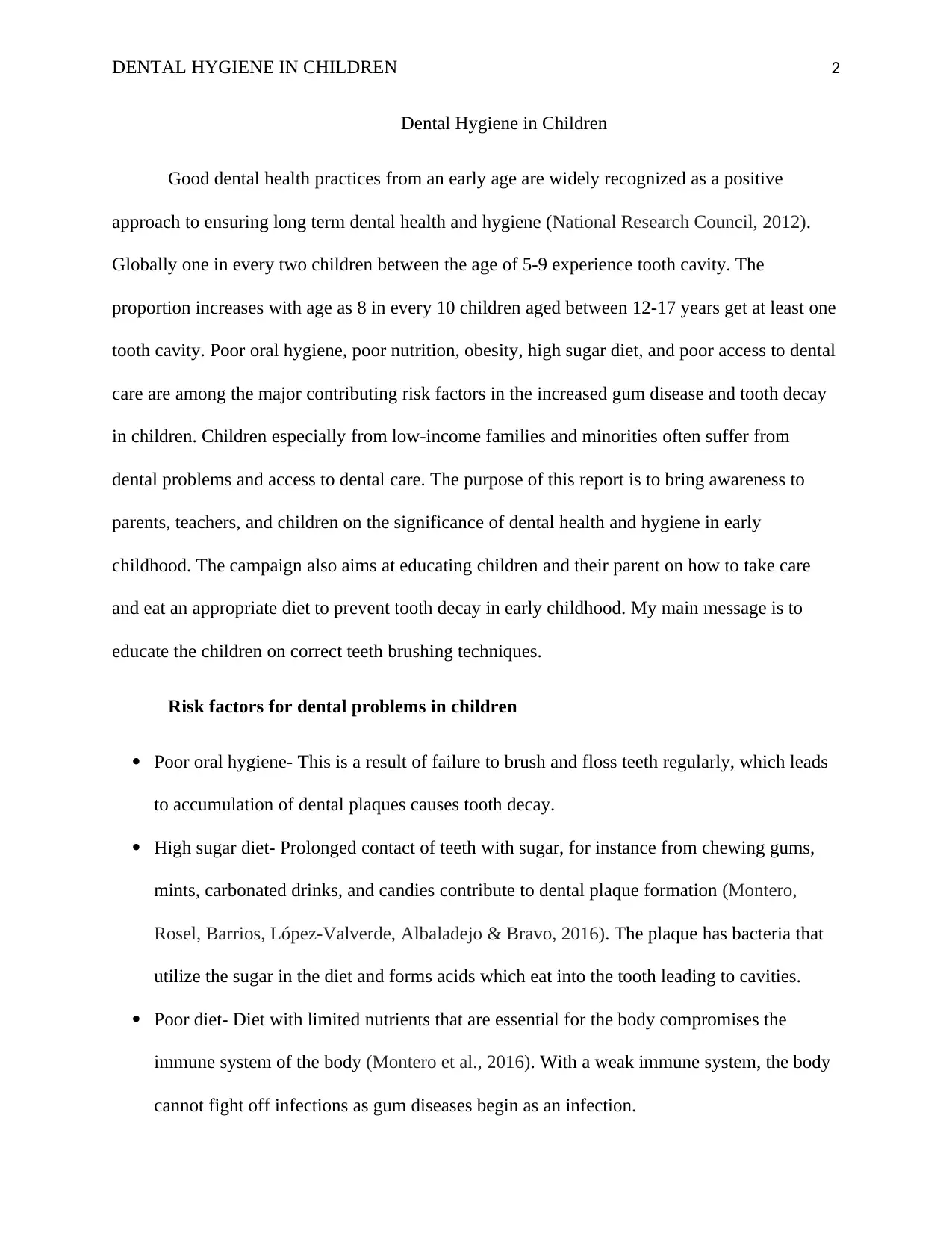
DENTAL HYGIENE IN CHILDREN 2
Dental Hygiene in Children
Good dental health practices from an early age are widely recognized as a positive
approach to ensuring long term dental health and hygiene (National Research Council, 2012).
Globally one in every two children between the age of 5-9 experience tooth cavity. The
proportion increases with age as 8 in every 10 children aged between 12-17 years get at least one
tooth cavity. Poor oral hygiene, poor nutrition, obesity, high sugar diet, and poor access to dental
care are among the major contributing risk factors in the increased gum disease and tooth decay
in children. Children especially from low-income families and minorities often suffer from
dental problems and access to dental care. The purpose of this report is to bring awareness to
parents, teachers, and children on the significance of dental health and hygiene in early
childhood. The campaign also aims at educating children and their parent on how to take care
and eat an appropriate diet to prevent tooth decay in early childhood. My main message is to
educate the children on correct teeth brushing techniques.
Risk factors for dental problems in children
Poor oral hygiene- This is a result of failure to brush and floss teeth regularly, which leads
to accumulation of dental plaques causes tooth decay.
High sugar diet- Prolonged contact of teeth with sugar, for instance from chewing gums,
mints, carbonated drinks, and candies contribute to dental plaque formation (Montero,
Rosel, Barrios, López‐Valverde, Albaladejo & Bravo, 2016). The plaque has bacteria that
utilize the sugar in the diet and forms acids which eat into the tooth leading to cavities.
Poor diet- Diet with limited nutrients that are essential for the body compromises the
immune system of the body (Montero et al., 2016). With a weak immune system, the body
cannot fight off infections as gum diseases begin as an infection.
Dental Hygiene in Children
Good dental health practices from an early age are widely recognized as a positive
approach to ensuring long term dental health and hygiene (National Research Council, 2012).
Globally one in every two children between the age of 5-9 experience tooth cavity. The
proportion increases with age as 8 in every 10 children aged between 12-17 years get at least one
tooth cavity. Poor oral hygiene, poor nutrition, obesity, high sugar diet, and poor access to dental
care are among the major contributing risk factors in the increased gum disease and tooth decay
in children. Children especially from low-income families and minorities often suffer from
dental problems and access to dental care. The purpose of this report is to bring awareness to
parents, teachers, and children on the significance of dental health and hygiene in early
childhood. The campaign also aims at educating children and their parent on how to take care
and eat an appropriate diet to prevent tooth decay in early childhood. My main message is to
educate the children on correct teeth brushing techniques.
Risk factors for dental problems in children
Poor oral hygiene- This is a result of failure to brush and floss teeth regularly, which leads
to accumulation of dental plaques causes tooth decay.
High sugar diet- Prolonged contact of teeth with sugar, for instance from chewing gums,
mints, carbonated drinks, and candies contribute to dental plaque formation (Montero,
Rosel, Barrios, López‐Valverde, Albaladejo & Bravo, 2016). The plaque has bacteria that
utilize the sugar in the diet and forms acids which eat into the tooth leading to cavities.
Poor diet- Diet with limited nutrients that are essential for the body compromises the
immune system of the body (Montero et al., 2016). With a weak immune system, the body
cannot fight off infections as gum diseases begin as an infection.
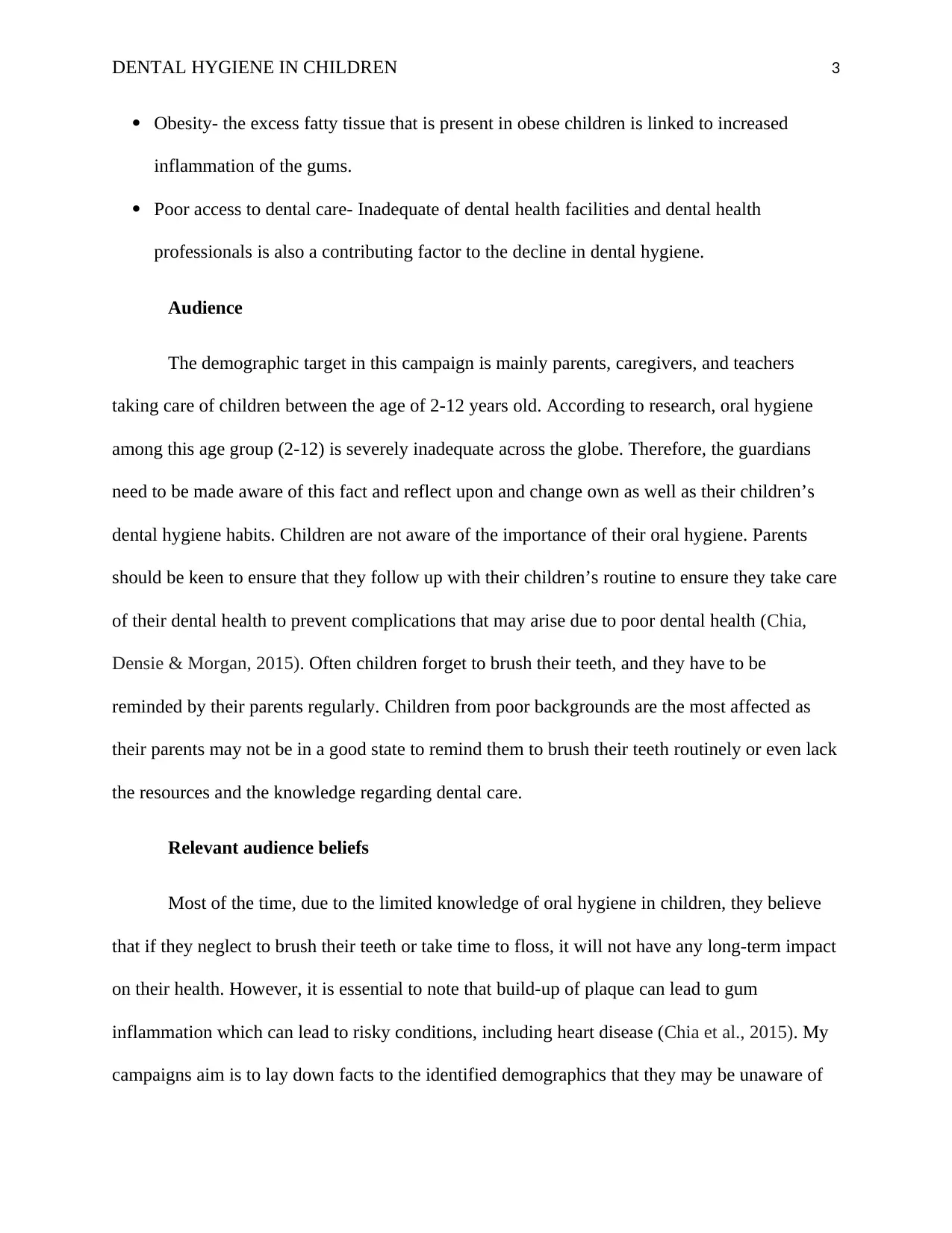
DENTAL HYGIENE IN CHILDREN 3
Obesity- the excess fatty tissue that is present in obese children is linked to increased
inflammation of the gums.
Poor access to dental care- Inadequate of dental health facilities and dental health
professionals is also a contributing factor to the decline in dental hygiene.
Audience
The demographic target in this campaign is mainly parents, caregivers, and teachers
taking care of children between the age of 2-12 years old. According to research, oral hygiene
among this age group (2-12) is severely inadequate across the globe. Therefore, the guardians
need to be made aware of this fact and reflect upon and change own as well as their children’s
dental hygiene habits. Children are not aware of the importance of their oral hygiene. Parents
should be keen to ensure that they follow up with their children’s routine to ensure they take care
of their dental health to prevent complications that may arise due to poor dental health (Chia,
Densie & Morgan, 2015). Often children forget to brush their teeth, and they have to be
reminded by their parents regularly. Children from poor backgrounds are the most affected as
their parents may not be in a good state to remind them to brush their teeth routinely or even lack
the resources and the knowledge regarding dental care.
Relevant audience beliefs
Most of the time, due to the limited knowledge of oral hygiene in children, they believe
that if they neglect to brush their teeth or take time to floss, it will not have any long-term impact
on their health. However, it is essential to note that build-up of plaque can lead to gum
inflammation which can lead to risky conditions, including heart disease (Chia et al., 2015). My
campaigns aim is to lay down facts to the identified demographics that they may be unaware of
Obesity- the excess fatty tissue that is present in obese children is linked to increased
inflammation of the gums.
Poor access to dental care- Inadequate of dental health facilities and dental health
professionals is also a contributing factor to the decline in dental hygiene.
Audience
The demographic target in this campaign is mainly parents, caregivers, and teachers
taking care of children between the age of 2-12 years old. According to research, oral hygiene
among this age group (2-12) is severely inadequate across the globe. Therefore, the guardians
need to be made aware of this fact and reflect upon and change own as well as their children’s
dental hygiene habits. Children are not aware of the importance of their oral hygiene. Parents
should be keen to ensure that they follow up with their children’s routine to ensure they take care
of their dental health to prevent complications that may arise due to poor dental health (Chia,
Densie & Morgan, 2015). Often children forget to brush their teeth, and they have to be
reminded by their parents regularly. Children from poor backgrounds are the most affected as
their parents may not be in a good state to remind them to brush their teeth routinely or even lack
the resources and the knowledge regarding dental care.
Relevant audience beliefs
Most of the time, due to the limited knowledge of oral hygiene in children, they believe
that if they neglect to brush their teeth or take time to floss, it will not have any long-term impact
on their health. However, it is essential to note that build-up of plaque can lead to gum
inflammation which can lead to risky conditions, including heart disease (Chia et al., 2015). My
campaigns aim is to lay down facts to the identified demographics that they may be unaware of
⊘ This is a preview!⊘
Do you want full access?
Subscribe today to unlock all pages.

Trusted by 1+ million students worldwide
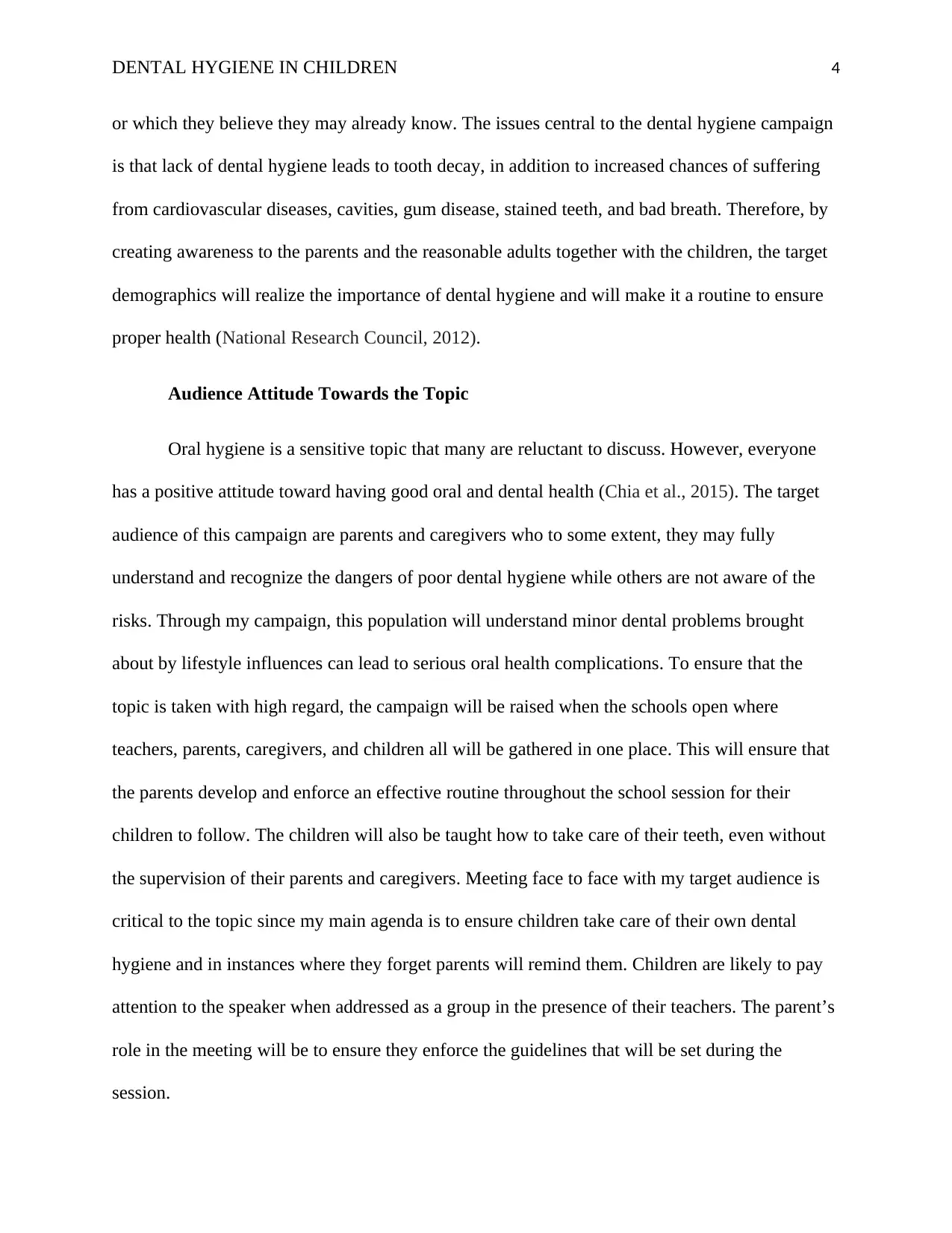
DENTAL HYGIENE IN CHILDREN 4
or which they believe they may already know. The issues central to the dental hygiene campaign
is that lack of dental hygiene leads to tooth decay, in addition to increased chances of suffering
from cardiovascular diseases, cavities, gum disease, stained teeth, and bad breath. Therefore, by
creating awareness to the parents and the reasonable adults together with the children, the target
demographics will realize the importance of dental hygiene and will make it a routine to ensure
proper health (National Research Council, 2012).
Audience Attitude Towards the Topic
Oral hygiene is a sensitive topic that many are reluctant to discuss. However, everyone
has a positive attitude toward having good oral and dental health (Chia et al., 2015). The target
audience of this campaign are parents and caregivers who to some extent, they may fully
understand and recognize the dangers of poor dental hygiene while others are not aware of the
risks. Through my campaign, this population will understand minor dental problems brought
about by lifestyle influences can lead to serious oral health complications. To ensure that the
topic is taken with high regard, the campaign will be raised when the schools open where
teachers, parents, caregivers, and children all will be gathered in one place. This will ensure that
the parents develop and enforce an effective routine throughout the school session for their
children to follow. The children will also be taught how to take care of their teeth, even without
the supervision of their parents and caregivers. Meeting face to face with my target audience is
critical to the topic since my main agenda is to ensure children take care of their own dental
hygiene and in instances where they forget parents will remind them. Children are likely to pay
attention to the speaker when addressed as a group in the presence of their teachers. The parent’s
role in the meeting will be to ensure they enforce the guidelines that will be set during the
session.
or which they believe they may already know. The issues central to the dental hygiene campaign
is that lack of dental hygiene leads to tooth decay, in addition to increased chances of suffering
from cardiovascular diseases, cavities, gum disease, stained teeth, and bad breath. Therefore, by
creating awareness to the parents and the reasonable adults together with the children, the target
demographics will realize the importance of dental hygiene and will make it a routine to ensure
proper health (National Research Council, 2012).
Audience Attitude Towards the Topic
Oral hygiene is a sensitive topic that many are reluctant to discuss. However, everyone
has a positive attitude toward having good oral and dental health (Chia et al., 2015). The target
audience of this campaign are parents and caregivers who to some extent, they may fully
understand and recognize the dangers of poor dental hygiene while others are not aware of the
risks. Through my campaign, this population will understand minor dental problems brought
about by lifestyle influences can lead to serious oral health complications. To ensure that the
topic is taken with high regard, the campaign will be raised when the schools open where
teachers, parents, caregivers, and children all will be gathered in one place. This will ensure that
the parents develop and enforce an effective routine throughout the school session for their
children to follow. The children will also be taught how to take care of their teeth, even without
the supervision of their parents and caregivers. Meeting face to face with my target audience is
critical to the topic since my main agenda is to ensure children take care of their own dental
hygiene and in instances where they forget parents will remind them. Children are likely to pay
attention to the speaker when addressed as a group in the presence of their teachers. The parent’s
role in the meeting will be to ensure they enforce the guidelines that will be set during the
session.
Paraphrase This Document
Need a fresh take? Get an instant paraphrase of this document with our AI Paraphraser
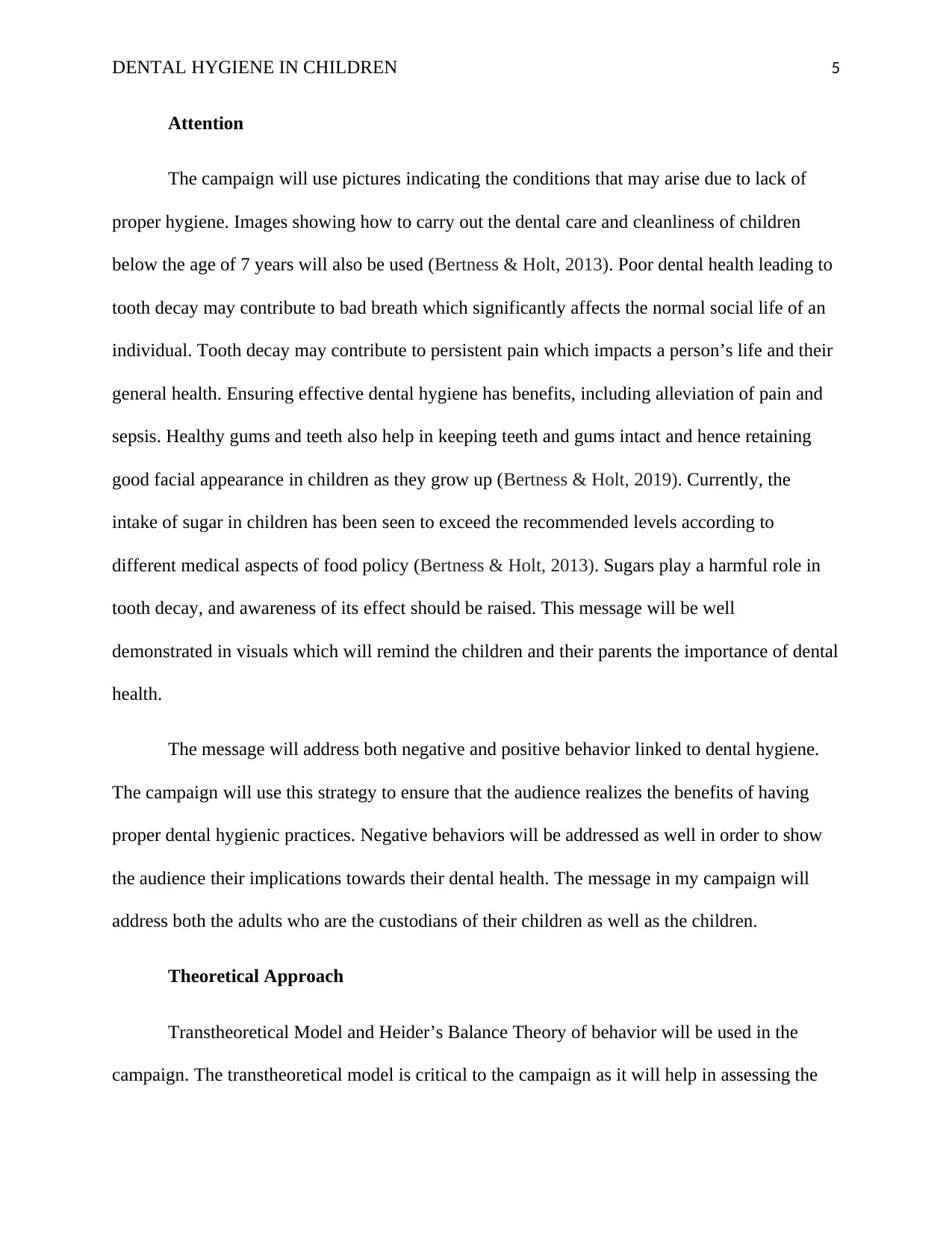
DENTAL HYGIENE IN CHILDREN 5
Attention
The campaign will use pictures indicating the conditions that may arise due to lack of
proper hygiene. Images showing how to carry out the dental care and cleanliness of children
below the age of 7 years will also be used (Bertness & Holt, 2013). Poor dental health leading to
tooth decay may contribute to bad breath which significantly affects the normal social life of an
individual. Tooth decay may contribute to persistent pain which impacts a person’s life and their
general health. Ensuring effective dental hygiene has benefits, including alleviation of pain and
sepsis. Healthy gums and teeth also help in keeping teeth and gums intact and hence retaining
good facial appearance in children as they grow up (Bertness & Holt, 2019). Currently, the
intake of sugar in children has been seen to exceed the recommended levels according to
different medical aspects of food policy (Bertness & Holt, 2013). Sugars play a harmful role in
tooth decay, and awareness of its effect should be raised. This message will be well
demonstrated in visuals which will remind the children and their parents the importance of dental
health.
The message will address both negative and positive behavior linked to dental hygiene.
The campaign will use this strategy to ensure that the audience realizes the benefits of having
proper dental hygienic practices. Negative behaviors will be addressed as well in order to show
the audience their implications towards their dental health. The message in my campaign will
address both the adults who are the custodians of their children as well as the children.
Theoretical Approach
Transtheoretical Model and Heider’s Balance Theory of behavior will be used in the
campaign. The transtheoretical model is critical to the campaign as it will help in assessing the
Attention
The campaign will use pictures indicating the conditions that may arise due to lack of
proper hygiene. Images showing how to carry out the dental care and cleanliness of children
below the age of 7 years will also be used (Bertness & Holt, 2013). Poor dental health leading to
tooth decay may contribute to bad breath which significantly affects the normal social life of an
individual. Tooth decay may contribute to persistent pain which impacts a person’s life and their
general health. Ensuring effective dental hygiene has benefits, including alleviation of pain and
sepsis. Healthy gums and teeth also help in keeping teeth and gums intact and hence retaining
good facial appearance in children as they grow up (Bertness & Holt, 2019). Currently, the
intake of sugar in children has been seen to exceed the recommended levels according to
different medical aspects of food policy (Bertness & Holt, 2013). Sugars play a harmful role in
tooth decay, and awareness of its effect should be raised. This message will be well
demonstrated in visuals which will remind the children and their parents the importance of dental
health.
The message will address both negative and positive behavior linked to dental hygiene.
The campaign will use this strategy to ensure that the audience realizes the benefits of having
proper dental hygienic practices. Negative behaviors will be addressed as well in order to show
the audience their implications towards their dental health. The message in my campaign will
address both the adults who are the custodians of their children as well as the children.
Theoretical Approach
Transtheoretical Model and Heider’s Balance Theory of behavior will be used in the
campaign. The transtheoretical model is critical to the campaign as it will help in assessing the
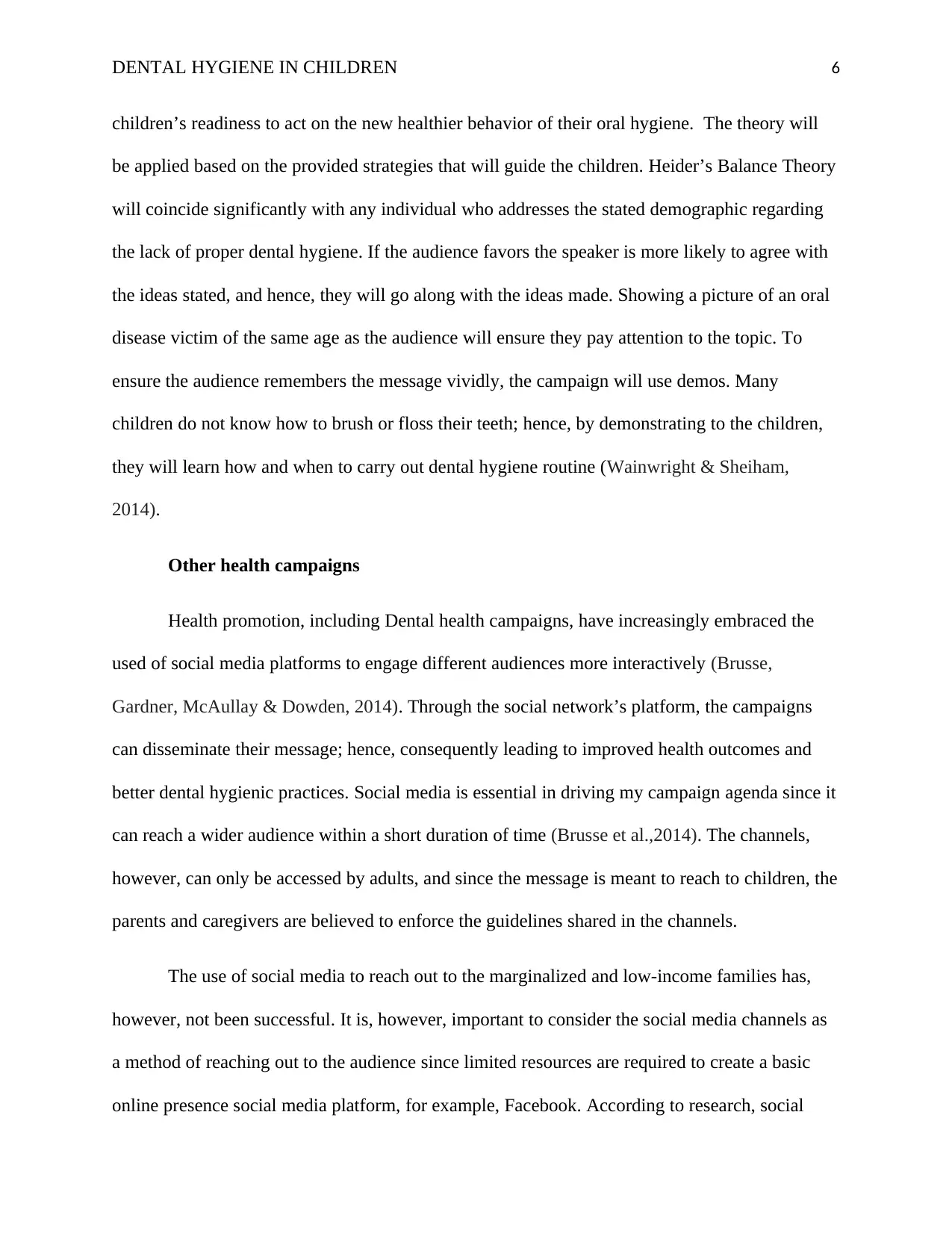
DENTAL HYGIENE IN CHILDREN 6
children’s readiness to act on the new healthier behavior of their oral hygiene. The theory will
be applied based on the provided strategies that will guide the children. Heider’s Balance Theory
will coincide significantly with any individual who addresses the stated demographic regarding
the lack of proper dental hygiene. If the audience favors the speaker is more likely to agree with
the ideas stated, and hence, they will go along with the ideas made. Showing a picture of an oral
disease victim of the same age as the audience will ensure they pay attention to the topic. To
ensure the audience remembers the message vividly, the campaign will use demos. Many
children do not know how to brush or floss their teeth; hence, by demonstrating to the children,
they will learn how and when to carry out dental hygiene routine (Wainwright & Sheiham,
2014).
Other health campaigns
Health promotion, including Dental health campaigns, have increasingly embraced the
used of social media platforms to engage different audiences more interactively (Brusse,
Gardner, McAullay & Dowden, 2014). Through the social network’s platform, the campaigns
can disseminate their message; hence, consequently leading to improved health outcomes and
better dental hygienic practices. Social media is essential in driving my campaign agenda since it
can reach a wider audience within a short duration of time (Brusse et al.,2014). The channels,
however, can only be accessed by adults, and since the message is meant to reach to children, the
parents and caregivers are believed to enforce the guidelines shared in the channels.
The use of social media to reach out to the marginalized and low-income families has,
however, not been successful. It is, however, important to consider the social media channels as
a method of reaching out to the audience since limited resources are required to create a basic
online presence social media platform, for example, Facebook. According to research, social
children’s readiness to act on the new healthier behavior of their oral hygiene. The theory will
be applied based on the provided strategies that will guide the children. Heider’s Balance Theory
will coincide significantly with any individual who addresses the stated demographic regarding
the lack of proper dental hygiene. If the audience favors the speaker is more likely to agree with
the ideas stated, and hence, they will go along with the ideas made. Showing a picture of an oral
disease victim of the same age as the audience will ensure they pay attention to the topic. To
ensure the audience remembers the message vividly, the campaign will use demos. Many
children do not know how to brush or floss their teeth; hence, by demonstrating to the children,
they will learn how and when to carry out dental hygiene routine (Wainwright & Sheiham,
2014).
Other health campaigns
Health promotion, including Dental health campaigns, have increasingly embraced the
used of social media platforms to engage different audiences more interactively (Brusse,
Gardner, McAullay & Dowden, 2014). Through the social network’s platform, the campaigns
can disseminate their message; hence, consequently leading to improved health outcomes and
better dental hygienic practices. Social media is essential in driving my campaign agenda since it
can reach a wider audience within a short duration of time (Brusse et al.,2014). The channels,
however, can only be accessed by adults, and since the message is meant to reach to children, the
parents and caregivers are believed to enforce the guidelines shared in the channels.
The use of social media to reach out to the marginalized and low-income families has,
however, not been successful. It is, however, important to consider the social media channels as
a method of reaching out to the audience since limited resources are required to create a basic
online presence social media platform, for example, Facebook. According to research, social
⊘ This is a preview!⊘
Do you want full access?
Subscribe today to unlock all pages.

Trusted by 1+ million students worldwide
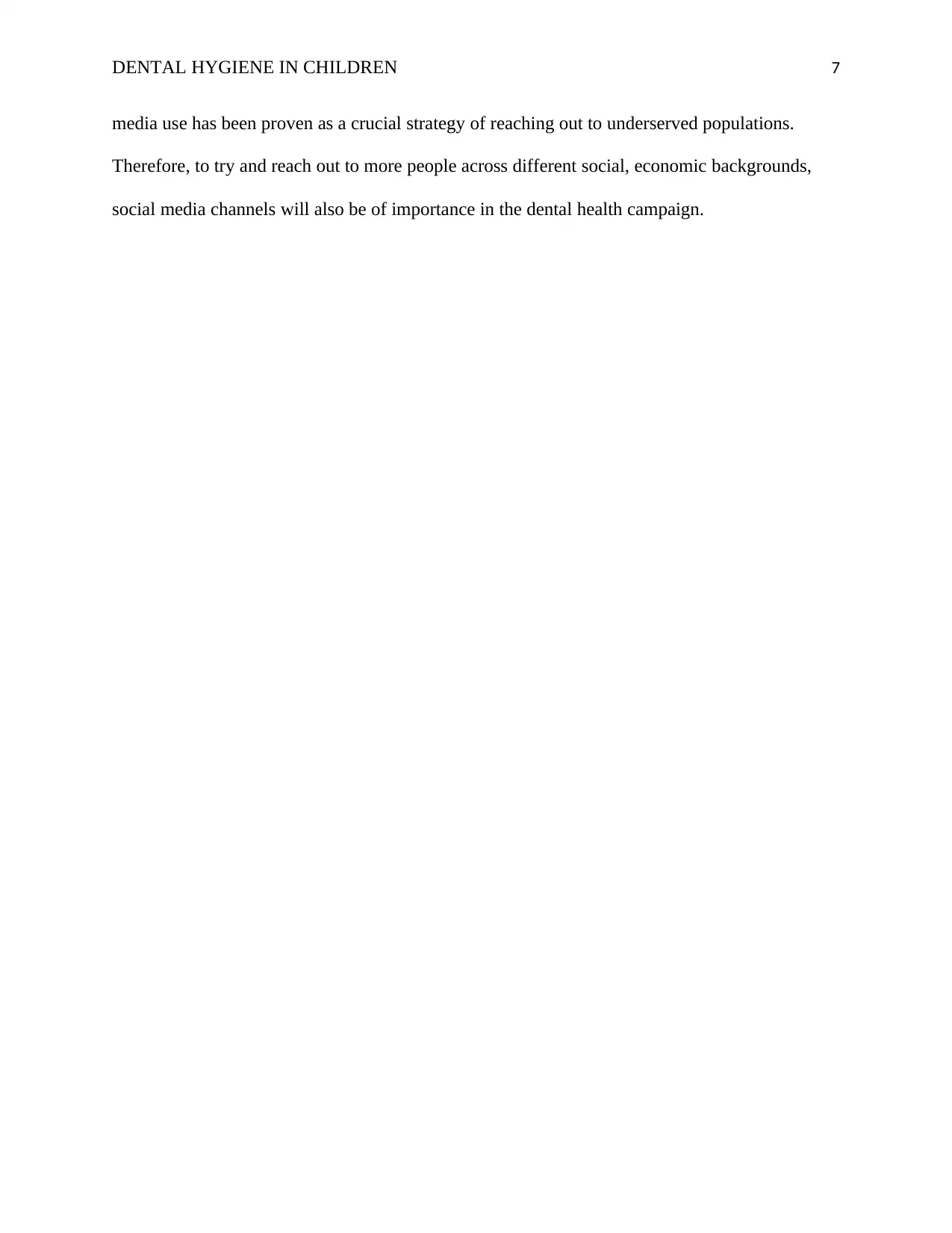
DENTAL HYGIENE IN CHILDREN 7
media use has been proven as a crucial strategy of reaching out to underserved populations.
Therefore, to try and reach out to more people across different social, economic backgrounds,
social media channels will also be of importance in the dental health campaign.
media use has been proven as a crucial strategy of reaching out to underserved populations.
Therefore, to try and reach out to more people across different social, economic backgrounds,
social media channels will also be of importance in the dental health campaign.
Paraphrase This Document
Need a fresh take? Get an instant paraphrase of this document with our AI Paraphraser
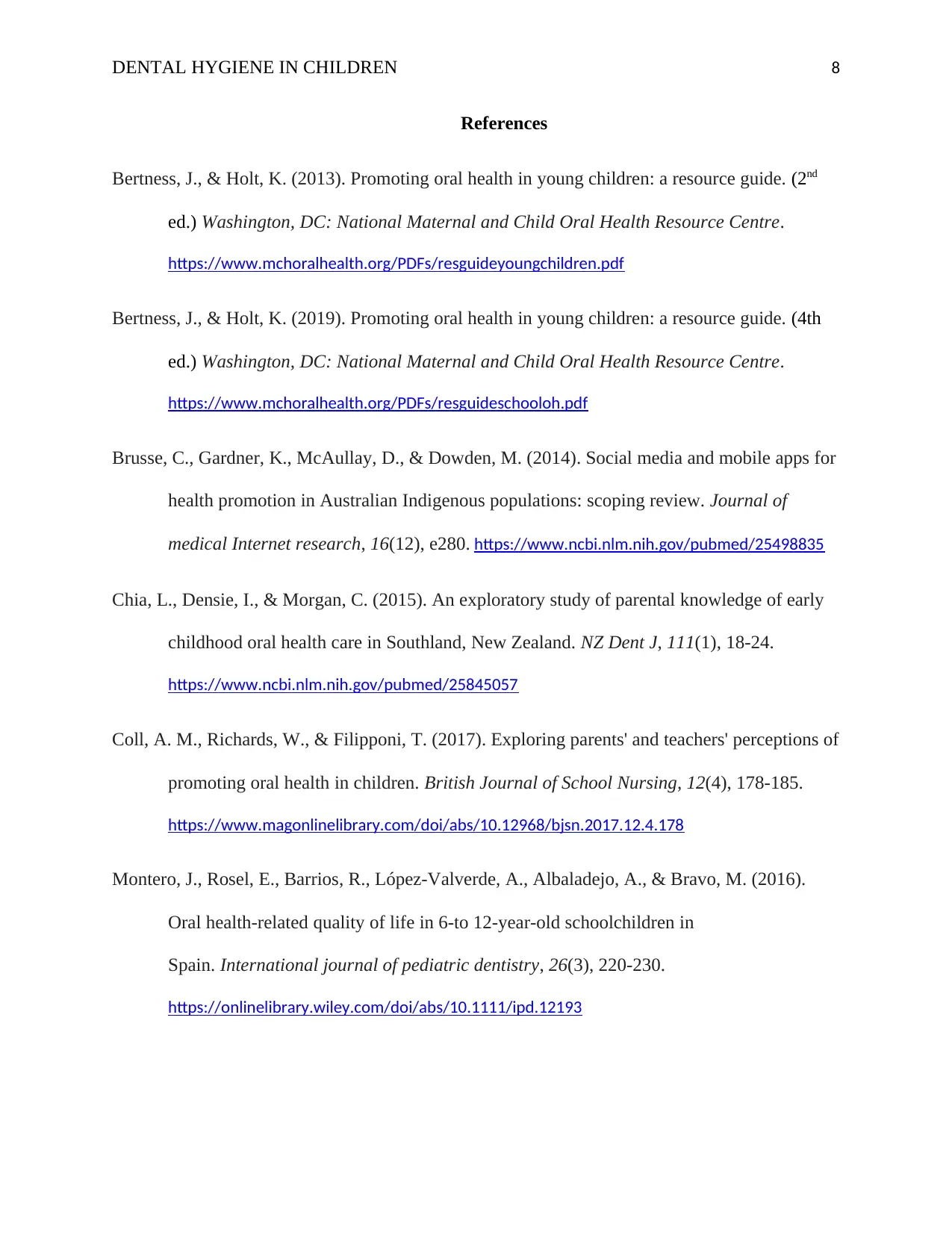
DENTAL HYGIENE IN CHILDREN 8
References
Bertness, J., & Holt, K. (2013). Promoting oral health in young children: a resource guide. (2nd
ed.) Washington, DC: National Maternal and Child Oral Health Resource Centre.
https://www.mchoralhealth.org/PDFs/resguideyoungchildren.pdf
Bertness, J., & Holt, K. (2019). Promoting oral health in young children: a resource guide. (4th
ed.) Washington, DC: National Maternal and Child Oral Health Resource Centre.
https://www.mchoralhealth.org/PDFs/resguideschooloh.pdf
Brusse, C., Gardner, K., McAullay, D., & Dowden, M. (2014). Social media and mobile apps for
health promotion in Australian Indigenous populations: scoping review. Journal of
medical Internet research, 16(12), e280. https://www.ncbi.nlm.nih.gov/pubmed/25498835
Chia, L., Densie, I., & Morgan, C. (2015). An exploratory study of parental knowledge of early
childhood oral health care in Southland, New Zealand. NZ Dent J, 111(1), 18-24.
https://www.ncbi.nlm.nih.gov/pubmed/25845057
Coll, A. M., Richards, W., & Filipponi, T. (2017). Exploring parents' and teachers' perceptions of
promoting oral health in children. British Journal of School Nursing, 12(4), 178-185.
https://www.magonlinelibrary.com/doi/abs/10.12968/bjsn.2017.12.4.178
Montero, J., Rosel, E., Barrios, R., López‐Valverde, A., Albaladejo, A., & Bravo, M. (2016).
Oral health‐related quality of life in 6‐to 12‐year‐old schoolchildren in
Spain. International journal of pediatric dentistry, 26(3), 220-230.
https://onlinelibrary.wiley.com/doi/abs/10.1111/ipd.12193
References
Bertness, J., & Holt, K. (2013). Promoting oral health in young children: a resource guide. (2nd
ed.) Washington, DC: National Maternal and Child Oral Health Resource Centre.
https://www.mchoralhealth.org/PDFs/resguideyoungchildren.pdf
Bertness, J., & Holt, K. (2019). Promoting oral health in young children: a resource guide. (4th
ed.) Washington, DC: National Maternal and Child Oral Health Resource Centre.
https://www.mchoralhealth.org/PDFs/resguideschooloh.pdf
Brusse, C., Gardner, K., McAullay, D., & Dowden, M. (2014). Social media and mobile apps for
health promotion in Australian Indigenous populations: scoping review. Journal of
medical Internet research, 16(12), e280. https://www.ncbi.nlm.nih.gov/pubmed/25498835
Chia, L., Densie, I., & Morgan, C. (2015). An exploratory study of parental knowledge of early
childhood oral health care in Southland, New Zealand. NZ Dent J, 111(1), 18-24.
https://www.ncbi.nlm.nih.gov/pubmed/25845057
Coll, A. M., Richards, W., & Filipponi, T. (2017). Exploring parents' and teachers' perceptions of
promoting oral health in children. British Journal of School Nursing, 12(4), 178-185.
https://www.magonlinelibrary.com/doi/abs/10.12968/bjsn.2017.12.4.178
Montero, J., Rosel, E., Barrios, R., López‐Valverde, A., Albaladejo, A., & Bravo, M. (2016).
Oral health‐related quality of life in 6‐to 12‐year‐old schoolchildren in
Spain. International journal of pediatric dentistry, 26(3), 220-230.
https://onlinelibrary.wiley.com/doi/abs/10.1111/ipd.12193
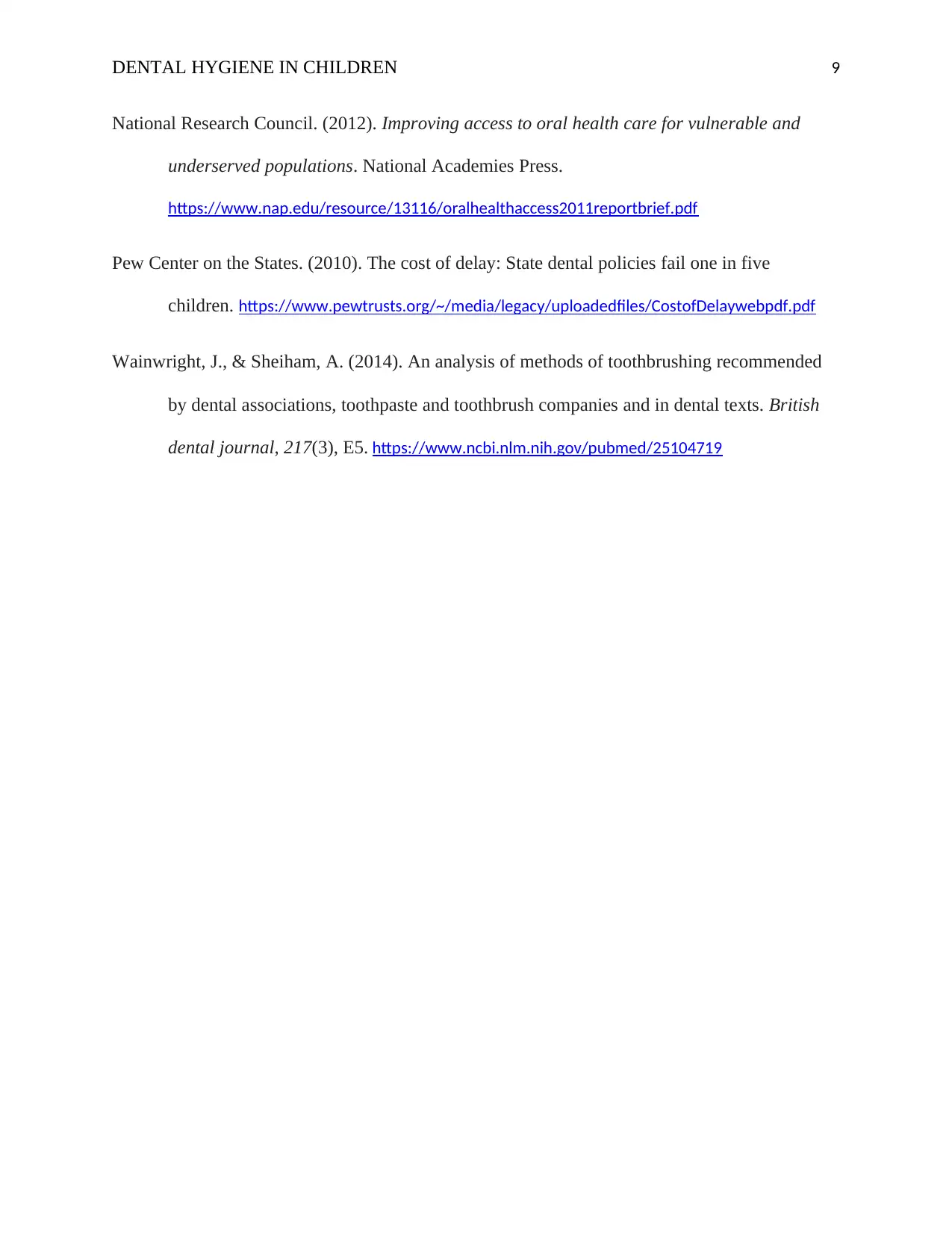
DENTAL HYGIENE IN CHILDREN 9
National Research Council. (2012). Improving access to oral health care for vulnerable and
underserved populations. National Academies Press.
https://www.nap.edu/resource/13116/oralhealthaccess2011reportbrief.pdf
Pew Center on the States. (2010). The cost of delay: State dental policies fail one in five
children. https://www.pewtrusts.org/~/media/legacy/uploadedfiles/CostofDelaywebpdf.pdf
Wainwright, J., & Sheiham, A. (2014). An analysis of methods of toothbrushing recommended
by dental associations, toothpaste and toothbrush companies and in dental texts. British
dental journal, 217(3), E5. https://www.ncbi.nlm.nih.gov/pubmed/25104719
National Research Council. (2012). Improving access to oral health care for vulnerable and
underserved populations. National Academies Press.
https://www.nap.edu/resource/13116/oralhealthaccess2011reportbrief.pdf
Pew Center on the States. (2010). The cost of delay: State dental policies fail one in five
children. https://www.pewtrusts.org/~/media/legacy/uploadedfiles/CostofDelaywebpdf.pdf
Wainwright, J., & Sheiham, A. (2014). An analysis of methods of toothbrushing recommended
by dental associations, toothpaste and toothbrush companies and in dental texts. British
dental journal, 217(3), E5. https://www.ncbi.nlm.nih.gov/pubmed/25104719
⊘ This is a preview!⊘
Do you want full access?
Subscribe today to unlock all pages.

Trusted by 1+ million students worldwide
1 out of 9
Related Documents
Your All-in-One AI-Powered Toolkit for Academic Success.
+13062052269
info@desklib.com
Available 24*7 on WhatsApp / Email
![[object Object]](/_next/static/media/star-bottom.7253800d.svg)
Unlock your academic potential
Copyright © 2020–2025 A2Z Services. All Rights Reserved. Developed and managed by ZUCOL.





